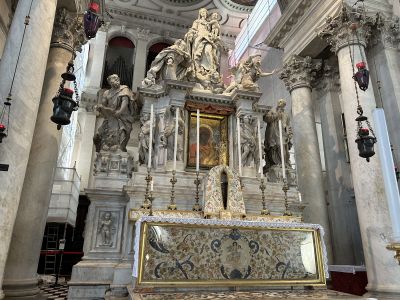The word altar comes from the Latin, altarium, meaning “high” and adolere, meaning “to ritually burn or sacrifice,” which suggests its original purpose was, as detailed in the Bible, sacrifice, adoration, and worship.
For Catholics, the Son of God is representative of the ultimate sacrifice. When He died on the Cross, He reconciled all humankind to God, making it possible for our sins to be forgiven and giving us the promise of eternal life with God. The altar plays a central role in the celebration of the Eucharist, and it is where the bread and wine are consecrated. The altar is situated in a designated consecrated space called the Sanctuary, placed at a higher elevation at the front of a church.
After the Second Vatican Council (1963-65) the long-standing practice of priests celebrating Mass with their backs turned to the worshipers was changed with altars repositioned so that the priest would face the people.
In 1993, Cardinal Joseph Ratzinger, powerful overseer of doctrine for the Roman Catholic Church, said he would like to see altars in Catholic churches turned around again. But his wish did not make it so.
Fascinated by the elaborate in-church altars, I took pictures of them on my trip to Italy this year. Notice that most, though not all, Catholic Churches have two altars, the original high altar in which the Priest faced away from the congregants and the newer, more simple ones which most Priests now use facing them. The present Roman Missal of the Catholic Church only requires that in new or renovated churches the facing-the-people orientation be made possible.
-
 Chiesa a San...
Chiesa a San...
Chiesa a San...
Chiesa a San...
-
 Chiesa del Santissimo...
Chiesa del Santissimo...
Chiesa del Santissimo...
Chiesa del Santissimo...
-
 Chiesa di Sansalvador...
Chiesa di Sansalvador...
Chiesa di Sansalvador...
Chiesa di Sansalvador...
-
 Chiesa di Santa...
Chiesa di Santa...
Chiesa di Santa...
Chiesa di Santa...
-
 Chiesa di Santo...
Chiesa di Santo...
Chiesa di Santo...
Chiesa di Santo...
-
 Chiesa e Convento...
Chiesa e Convento...
Chiesa e Convento...
Chiesa e Convento...
-
 Chiesa di Santi...
Chiesa di Santi...
Chiesa di Santi...
Chiesa di Santi...
-
 Parrocchia di St....
Parrocchia di St....
Parrocchia di St....
Parrocchia di St....
-
 Rettorio di San...
Rettorio di San...
Rettorio di San...
Rettorio di San...
-
 Sannicola in Carcere
Sannicola in Carcere
Sannicola in Carcere
Sannicola in Carcere
-
 Santa Lucia alla...
Santa Lucia alla...
Santa Lucia alla...
Santa Lucia alla...
-
 Santa Maria delle...
Santa Maria delle...
Santa Maria delle...
Santa Maria delle...
-
 Santuario della Madonna...
Santuario della Madonna...
Santuario della Madonna...
Santuario della Madonna...
https://www.lagazzettaitaliana.com/photo-exhibit/10328-altars#sigProIdfc525a3f70



